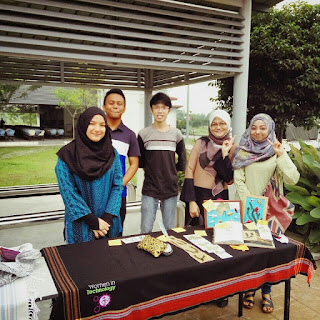Product 1: Mini Aquascape
Our plan was to make a small and affordable aquascape where others could enjoy their own small ecosystem. We managed to get some aquarium dirt and collected Cabomba sp. to be placed in our small cylindrical container. To make one of these samples, the soil must be prepared first. About 2 inches of soil is placed into the container and dechlorinated water is poured until desired water level. The container is then left for 1 week before any plants is planted. A hardy freshwater plant is selected and planted into the soil and sunlight is provided 12h per day. Once everything is stable, a suitable fish species such as the guppy is placed into the container and the whole mini aquascape is completed. Production cost: RM5, Sold for RM10
 |
| Image 1: Phytoteam Mini Aquascape. |
In this product, we decide to sell preserved aquatic plants that can be enjoyed by everyone with a very low cost. Each aquatic plants was carefully selected and cleaned before drying. After about 7 days, the samples can be collected and made into bookmarks. Completed samples comes along with their scientific name for better identification. Production Cost: RM0(using supplies that was already provided) Sold for RM 2 each
 |
| Image 2: Phytoteam Herbarium Bookmark. |
Product 3: Herbarium Collage
In this product, we aim to add some artistic value using herbarium samples of aquatic macrophytes and turning them into simple piece of art. Production cost: RM5 Sold for RM10 and RM25.
 |
| Image 3: Our finished product sold for Rm25. |
Product 4: Moss Grafitti
This product was a pilot project to observe whether making a moss graffiti is possible using the same ingredients from the net. The turn out was satisfying however, we was not able to properly maintain the sample with daily spraying which resulted in dried samples. In the future, a proper moist condition should be provided to allow the moss to grow.
 |
| Image 4: Cleaning collected moss from stones and debris. |
 |
| Image 5: Preparing media with 1 part salt, 2 parts brown sugar. |
 |
| Image 6: Adding 300ml of milk into the media. |
 |
| Image 7: A cup of cleaned moss is added into the mixer. |
 |
| Image 8: The media and moss was mixed thoroughly but not finely as this may damage the moss. |
 |
| Image 9: Prepared media with moss that is ready for painting. |
 |
| Image 10: Spreading of moss media onto wood surface and left to grow for a week. |
Product Marketing on 17 December 2015 under Flora Aqua Arts Day 2015.
 |
| Image 11: Setting up our booth. |
 |
| Image 12: Getting ready for students and lecturers to come by, |
 |
| Image 13: Promoting our products and exposing students and lecturers about the world of aquatic flora. |
Image 14: Some products for sale including Herbarium bookmarks and herbarium collages.
No comments:
Post a Comment